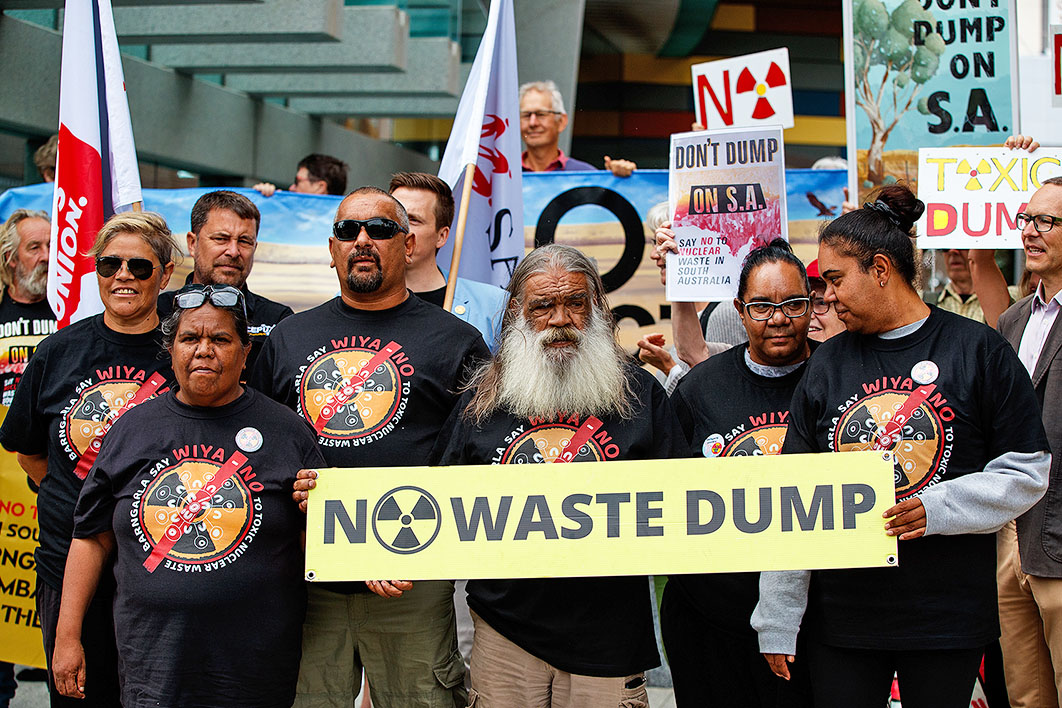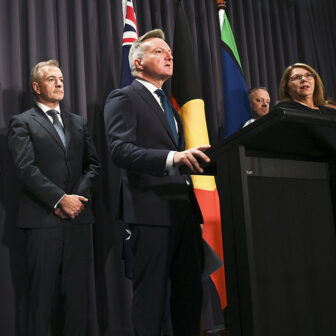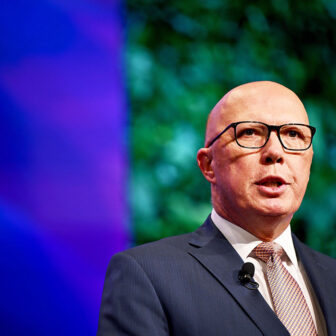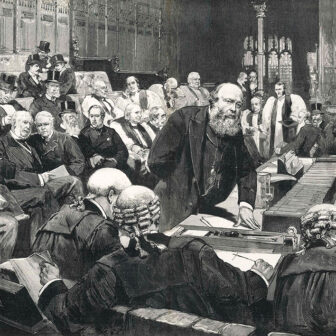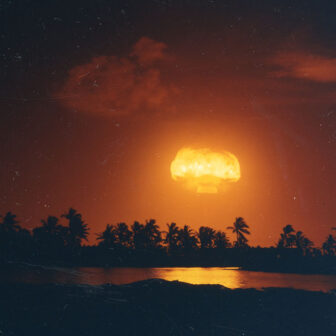Critics of the Commonwealth’s plan to house Australia’s nuclear waste in remote South Australia are celebrating last Thursday’s announcement that the federal government has abandoned the plan for a national radioactive waste management facility at Napandee, near Kimba on South Australia’s Eyre Peninsula.
Resources minister Madeleine King announced that all activities at the site will end immediately, apologised for the “uncertainty” experienced by Kimba residents and acknowledged her regret for the “profound distress” experienced by Traditional Owners — the Barngarla people — during the decision-making process.
King’s announcement came less than a month after the Barngarla Determination Aboriginal Corporation’s campaign against the facility culminated in a breakthrough Federal Court verdict. Justice Natalie Charlesworth ruled that the decision to store Australia’s nuclear waste at Napandee was subject to “apprehended bias” and should thus be set aside. Her decision has been labelled a “king hit” for plans to dispose of Australia’s low- to intermediate-level nuclear waste.
But while many assume that the ruling rested on native title (an issue that was certainly discussed), the minister wanted to make clear that the “question raised in this case was about a decision-making process, not a claim of native title.” In reality, the judgement was a comment on consecutive Australian governments’ inability to take public anxieties about nuclear waste seriously, a tendency stretching back decades.
As Justice Charlesworth detailed, the evidence led her to conclude that former resources minister Keith Pitt had “already made up his mind about the selection of Napandee as the site” ahead of its formal determination. By making statements “to the effect that the Australian Government had made a commitment or promise to the people of Kimba that a radioactive waste facility would be situated at Napandee,” Pitt was judged to have shown apprehended bias — that is, his mind was “foreclosed” to the possibility that the post-nomination consultation would change the outcome.
Justice Charlesworth found that Pitt also displayed a “dismissive attitude to its key opponents, the Barngarla people.” Describing the judgement as the conclusion of a “David and Goliath” battle, the Barngarla Determination Aboriginal Corporation’s chair, Jason Bilney, reflected on the outcome in light of truth-telling: “It’s about listening to the First Nations people, and here we are today and we prevailed and we won.”
Napandee was a latecomer to the process of deciding where Australia’s nuclear waste would be stored. The first round of applications had resulted in just one suitable site: Wallerberdina Station, near Hawker, in South Australia’s Flinders Ranges. Seeking further options in late 2016, resources minister Matt Canavan approved an amendment to the nomination guidelines to allow private landholders to nominate their own properties for consideration. Early the following year, the federal government received several new sites for consideration; one of them was Napandee, a 160-hectare property put forward by owner Jeff Baldock.
With these new sites in contention, efforts began in Hawker and Kimba to gauge local support for the facility. Several ballots conducted as part of the consultation process returned a slim majority vote against hosting Australia’s nuclear waste in Hawker (48–52) and a majority for hosting it in Kimba (62–38). Both communities were divided, and in both cases the Traditional Owners argued they had been “locked out” of voting and not adequately consulted. Once Napandee was selected as the final location in 2020, the Barngarla committed to having the decision reversed.
Justice Charlesworth’s judgement might be a welcome one for the Traditional Owners but it by no means marks the end of the wider debate over the storage of Australia’s nuclear waste. After all, Australians have been here before and will undoubtedly find themselves here again.
If it feels as though the issue of radioactive waste has been in the news for a very long time, that’s because it has. For decades, politicians, experts and the public have debated the ins and outs of radioactive waste storage and disposal in Australia. As the debate rages on, the nation’s nuclear waste mounts.
Australia’s existing waste consists mainly of low-level radioactive waste products and contaminated materials used in medicine, industry and scientific research: contaminated PPE, for example, and unused radiopharmaceuticals and contaminated gowns and bedlinen. The nation’s radioactive waste burden is partly the consequence of saving countless lives: in 2022 alone, 300,000 nuclear medicine diagnostic exams were claimed on Medicare, each of them producing both low- and intermediate-level nuclear waste.
Regardless of radioactive materials’ positive uses, the mental leap from nuclear waste to barrels of toxic sludge, ballooning mushroom clouds and radiation sickness shouldn’t be dismissed. Uncertainty about radioactivity’s association with cancer and other serious health concerns, its impact on the environment and the contradictory way it appears to be handled and approached by authorities induce unease. Rather than treat these anxieties as baseless, decision-makers need to face them head-on and deal with them seriously.
This was exactly the advice given to the Keating government in the No Time to Waste report released by the Senate Select Committee on the Dangers of Radioactive Waste in 1996. The committee found that the rules and regulations governing nuclear waste storage were not only difficult to understand but were also inadequately enforced. The rules themselves hadn’t kept up with shifting international standards and appeared to operate differently from state to state. Coming after a nuclear waste spill at Port Augusta in 1991, these conclusions would only have increased public concern.
The more recent case of a radioactive capsule lost in remote Western Australia is a good reminder of why such concern prevails. Australians were told not to be concerned by the misplaced 8mm diameter capsule, but — in the same breath — were “urged” not to touch it. Chief health officer Andrew Robertson, who chairs the Radiological Council of Western Australia, warned that coming into contact with the tiny capsule “could cause radiation burns or severe illness.”
Once it was found, though, the public health risk associated with the capsule was reported as having been extremely remote. The contradictory messages, and the lapses of security with which they were associated, caused understandable apprehension.
But accidents like these don’t just fuel anxiety. They also fuel discussion of the need for a national remedy to the risks posed by the decentralised handling of potentially dangerous radioactive materials. At present, Australia’s nuclear waste is housed at over one hundred sites across the country — some of them in populous areas — including hospitals, universities, mines and the Lucas Heights reactor in Sydney. Proposals for national repositories to centralise these storages extend back at least to 1998.
The proposal most like the one successfully opposed last month came in 1998, when prime minister John Howard took up the Senate committee’s recommendation of two years earlier that the government begin seeking a site for a national, well-regulated waste repository. Opposition flowed thick and fast, laced with fears that placing the waste in the desert would merely put it “out of sight, out of mind.”
Ever conscious of the radioactive legacies of British nuclear testing at Maralinga and Emu Field, and also aware of the waste generated at the large-scale Olympic Dam mine, many South Australians resented the suggestion that theirs would become the nuclear waste state. But it wasn’t the state’s nuclear past that determined the repository’s fate; it was the government’s determination to stick to a “decide and defend” model of site location, as Griffith University’s Ian Lowe recently described it.
Cabinet papers released earlier this year detail the Howard government’s plans to defy opposition from South Australians. They reveal cabinet’s commitment to defending the government’s choice of site through “the compulsory acquisition of… native title rights and interests in the area” and the overriding of “any South Australian legislation which seeks to prohibit the establishment of the national repository.”
South Australia’s Rann government brought a Federal Court case against the Commonwealth in 2004, arguing that attempts to compulsorily acquire land in South Australia for nuclear waste storage were unlawful. As it did last month, the Federal Court ruled in favour of the applicants.
Howard subsequently announced the government’s decision to “abandon” the repository because of a “failure of the states and territories to cooperate with the Australian Government in finding a national solution for the safe and secure disposal of low level radioactive waste.” What might have been interpreted by Howard as a failure by the states to cooperate with his government would have been interpreted by affected communities as the federal government’s failure to cooperate with them. Precisely the same accusation was levelled by the Barngarla.
In light of this month’s ruling, and echoing Howard, Minister King last week reaffirmed her government’s commitment to safely storing and disposing of Australia’s nuclear waste. Looking ahead, though, AUKUS and Australia’s acquisition of nuclear submarines will profoundly affect this commitment. And only last week Nationals leader David Littleproud reaffirmed the Coalition’s view that Australia should go nuclear.
Larger-scale nuclear pursuits — including nuclear submarines — would undoubtedly complicate Australia’s nuclear waste disposal. To date, Australian governments, Coalition and Labor, have been unable to secure widespread public support for a national storage or disposal facility for low- to intermediate-level radioactive waste. Yet the AUKUS security pact makes Australia responsible for the storage of high-level waste produced by its submarine fleet.
Despite assurances that this won’t be a problem until at least the 2050s, the prospect is well worth considering in light of the Federal Court’s ruling. This judgement, like those that came before it, demonstrates that nuclear waste storage and disposal in Australia isn’t necessarily an issue of technical ability (though this remains up for debate); rather, it requires governments to both obtain community consent and allay public concerns.
As King made clear, a national waste facility “requires broad community support.” This doesn’t mean simply obtaining the support of ratepayers or property owners — it means the whole community. And while this is undoubtedly an immense task, if the recent and earlier judgements teach us anything, it is that an issue like this won’t be resolved until communities’ voices are heard and apprehensions adequately considered. •
